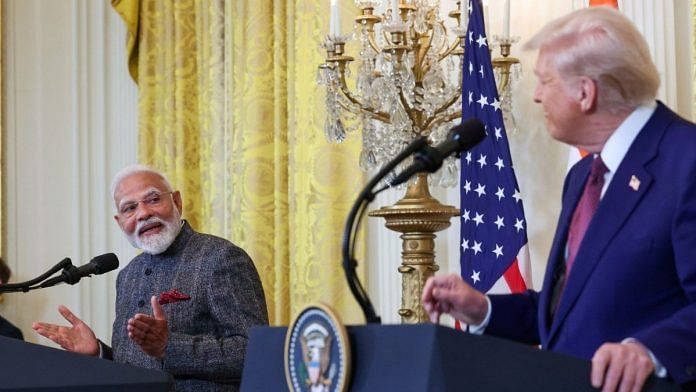The tenth edition of the Raisina Dialogue, inaugurated by Prime Minister Narendra Modi, was held at New Delhi from 17-19 March 2025. Almost ten years since its inception, this event, co-sponsored by the Ministry of External Affairs and the Observer Research Foundation, has grown in stature, attracting senior statespersons and diplomats from the world over. This forum, which provides a platform for addressing global issues—ranging from geopolitics to climate change—through discussions and debates, concurrently cemented India’s role as a key player in the region, as acknowledged by several foreign speakers. Visiting dignitaries also used this opportunity to meet their Indian counterparts and to hold meetings with key thought leaders on the sidelines of the main event. An underlying current throughout the discussions was the global fallout arising out of the domestic and foreign policies of the Trump 2.0 administration, with concerns voiced more markedly in closed-door sessions.
The ‘America First’ approach has upended the global order, which had grown accustomed to the status quo, putting a question mark on long-standing alliances, turning friends into foes, and even driving foes closer to each other. This kind of disruptive leadership challenges established institutions and bureaucratic structures, often leading to better and more efficient outcomes. At the very least, the initial pronouncements have forced regions and groupings to acknowledge and take ownership of their problems. Nowhere is this truer than for the European Union and its NATO members. It is worth recalling External Affairs minister S Jaishankar’s remark, “…Europe thinks that its problems are the world’s problems, [but]…the world’s problems are not Europe’s problems…”. Similarly, the threat to take over the Gaza Strip and turn it into a Riviera of the East sent regional countries in West Asia scurrying to counter such a disruptive proposal.
The US, by brokering talks between Ukraine and Russia and by even reaching out and offering concessions to Putin, once again underscored the need to bring a cessation to hostilities, even if temporarily. This approach was unthinkable under the previous administration. It echoes Prime Minister Modi’s prescient remark that “This is not an era of war”. This outreach by the US to Russia also vindicated India’s very principled approach to the conflict, the exercise of its strategic autonomy and how it has balanced its relations with the US, Russia and China. Had India forsaken its long-time partner Russia under US pressure, it would now have been in an unviable and embarrassing position in the face of the US turnaround.
The tariffs imposed by the US unilaterally and unleashed without exception on nations across the globe have the potential to disrupt global trade and the world economy. It is too early to say whether these tariffs will be beneficial to the US or the global economy. However, in response, some countries have offered concessions leading to a softening of the US stance. Others have responded in equal measure, with China even going as far as to say that “If war is what the US wants, be it a tariff war, a trade war or any other type of war, we’re ready to fight till the end”. The gauntlet has been thrown, and only time will tell whether trade wars will lead to actual conflict. In the short term, it has brought China and India closer together, in spite of the long-standing border dispute. As countries seek new trading partners, this decoupling could hurt the US in the long run.
Also read: India’s anti-tank missile dilemma—build, buy, or scramble for quick fix when crisis hits border
What should India do?
Seen holistically, these changes could have certain advantages for India, but they come with their own set of challenges. On the positive side, any downturn in US-China ties will allow India to project itself as an alternative to Beijing in the manufacturing sector, a stable hub in the global supply chain. It is also something that India sorely needs if it is to generate mass employment opportunities for its youth. Renewed focus on strengthening defence cooperation and impetus to the QUAD gives a fillip to India’s regional aspirations and fits well in the US’ search for allies in the Asia-Pacific region to counter China’s rise.
On the flip side, fluid policies on various issues, particularly on trade, make it difficult for India to adapt to an ever-changing global economic dynamic, especially in light of its ponderous bureaucratic processes. Our own policies will have to be quick to adapt and implement to stay ahead of the curve. Furthermore, tough immigration policies, especially regarding H-1B visas, will seriously disadvantage Indian workers, especially in the tech community. They not only contribute significantly to the US economy, but are also a significant factor towards inward remittance to India, second only to the UAE. Similarly, the US’ unilateral withdrawal from global bodies and agreements, particularly on climate change, will severely test India’s diplomatic skills.
In navigating this dynamic geopolitical landscape, we also need to be aware of the dangers that lurk ahead. Notwithstanding its pre-eminent geo-strategic location, India must not over-commit to any grouping or alliance lest it limit its ability to engage with other countries or its ability to play the honest broker in response to crises. We must also give salience to our Neighbourhood First policy, not only to ensure regional stability but also to keep China at bay. At the same time, we must eschew the temptation of military solutions to regional problems, instead focus on economic agreements, diplomatic engagements and leveraging our soft power to advance our interests. Finally, with increasing reliance on technology in all facets of daily life, especially in defence and national level grids, India must ensure that cybersecurity becomes a critical component of the overall national security architecture, and that the capabilities are robust enough to guard against the omnipresent cyber threats.
General Manoj Mukund Naravane PVSM AVSM SM VSM is a retired Indian Army General who served as the 28th Chief of the Army Staff. Views are personal.
(Edited by Theres Sudeep)






